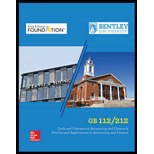
Compute the given ratios for Company UO.
Answer to Problem 13.2CP
Compute the given ratios for Company UO.
| Ratio | Formula | Calculation | Result |
| Return on Equity (ROE) | 15.38% | ||
| Earnings per share (EPS) | As given in income statement | $1.70 | |
| Net profit margin | 7.00% | ||
| Inventory turnover | 6.42 times | ||
| Current ratio | 2.29 times | ||
| Debt-to-equity ratio | 0.42 times | ||
| Price/Earnings (P/E) ratio | 23.53 times | ||
| Dividend yield ratio | 0%% |
Table (1)
Explanation of Solution
Return on equity ratio:
Return on equity of the Company UO is 15.38 %.
Earnings per share:
Earnings per share help to measure the profitability of a company. Earnings per share are the amount of profit that is allocated to each share of outstanding stock.
Earnings per share of the Company UO is $1.70
Profit margin:
Profit margin ratio is used to determine the percentage of net income that is being generated per dollar of revenue or sales.
Net profit margin of the Company is 7.00 %.
Inventory turnover ratio:
Inventory turnover ratio is used to determine the number of times inventory used or sold during the particular accounting period.
Inventory turnover ratio of the Company UO is 7.46%.
Current ratio is used to determine the relationship between current assets and current liabilities. The ideal current ratio is 2:1.
Current ratio of the Company UO is 2.29 times.
Debt-equity ratio:
The debt-to-equity ratio indicates that the company’s debt as a proportion of its stockholders’ equity.
Debt-to-Equity ratio of the Company UO is 0.42 times.
Price/Earnings Ratio: It depicts the relation of market price of a share to earnings per share of that company. The price/earnings ratio presents the market value of the amount invested to earn $1 by a company. It is major tool to be used by investors before the decisions related to investments in a company.
Price/Earnings ratio of the Company UO is 23.53 times.
Dividend yield: This is the ratio which measures the amount of dividends paid relative to the market price.
Dividend yield ratio of the Company UO is 0%%.
Want to see more full solutions like this?
Chapter 13 Solutions
GB 112/212 MANAGERIAL ACC. W/ACCESS >C<
- I am looking for a reliable way to solve this financial accounting problem using accurate principles.arrow_forwardPlease show me how to solve this financial accounting problem using valid calculation techniques.arrow_forwardCould you help me solve this financial accounting question using appropriate calculation techniques?arrow_forward
- How can I solve this financial accounting problem using the appropriate financial process?arrow_forwardhow much overhead cost would be assigned to product G98X using the activity based costing system ?arrow_forwardThe closing price of a stock is $74.55, and the net earnings per share are $3.50. The stock's P/E ratio is .arrow_forward
 College Accounting, Chapters 1-27AccountingISBN:9781337794756Author:HEINTZ, James A.Publisher:Cengage Learning,
College Accounting, Chapters 1-27AccountingISBN:9781337794756Author:HEINTZ, James A.Publisher:Cengage Learning, Managerial AccountingAccountingISBN:9781337912020Author:Carl Warren, Ph.d. Cma William B. TaylerPublisher:South-Western College Pub
Managerial AccountingAccountingISBN:9781337912020Author:Carl Warren, Ph.d. Cma William B. TaylerPublisher:South-Western College Pub Financial And Managerial AccountingAccountingISBN:9781337902663Author:WARREN, Carl S.Publisher:Cengage Learning,
Financial And Managerial AccountingAccountingISBN:9781337902663Author:WARREN, Carl S.Publisher:Cengage Learning, EBK CONTEMPORARY FINANCIAL MANAGEMENTFinanceISBN:9781337514835Author:MOYERPublisher:CENGAGE LEARNING - CONSIGNMENTCentury 21 Accounting Multicolumn JournalAccountingISBN:9781337679503Author:GilbertsonPublisher:Cengage
EBK CONTEMPORARY FINANCIAL MANAGEMENTFinanceISBN:9781337514835Author:MOYERPublisher:CENGAGE LEARNING - CONSIGNMENTCentury 21 Accounting Multicolumn JournalAccountingISBN:9781337679503Author:GilbertsonPublisher:Cengage Excel Applications for Accounting PrinciplesAccountingISBN:9781111581565Author:Gaylord N. SmithPublisher:Cengage Learning
Excel Applications for Accounting PrinciplesAccountingISBN:9781111581565Author:Gaylord N. SmithPublisher:Cengage Learning





